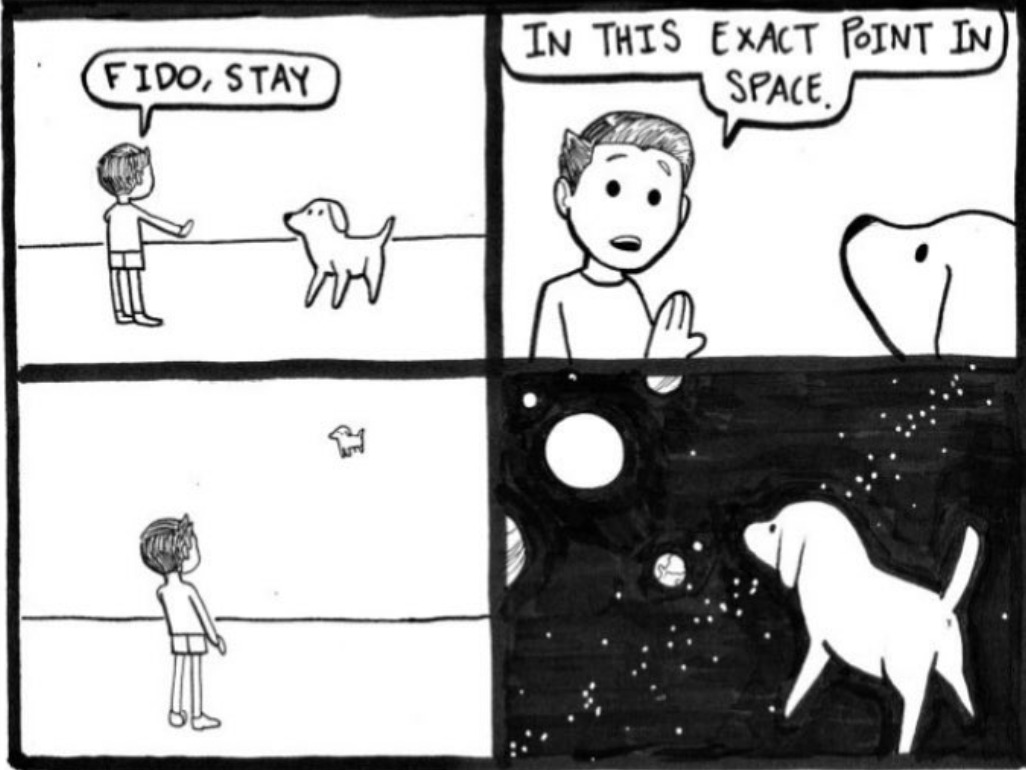Thank you for this daily dose of existential dread 👌
Are they also unbound by momentum?
TIL that ghosts are pinned to the lumineferous aether.
With the Earth’s elliptical orbit, momentum would only get you so far in terms of sticking with the planet.
relative to the galactic central point, per Eric Idle, the earth would be 200k/125 miles away in a single second, or relative to everything in the universe / background radiation, it would be 23,000 miles (37,000 km) away in a single second.
Preserving momentum in different directions and you quickly double it
Assuming an even rate of death, that’s just under 2 people dying per second currently, so you wouldn’t even be able to see the people who died before or after you if you retained human senses as a ghost.
If this were true we could then actually use ghosts to determine the “true” universal reference frame, right?
… Boo.
Even with a circular orbit, if you’re unbound by gravity you’ll follow a straight path while the Earth curves, resulting in it appearing to accelerate away from you.
Yeah they would go flying off into space relative to earth but I was more referring to the idea that they’d somehow become stationary due to being immune to gravity. That wouldn’t be sufficient on its own.

The butthole is what really makes this comic
Now we know what dark matter is
Einstein would like to have a word with you
several physicists are typing…
We already had a discussion about how that doesn’t make sense with this different comic: https://lemmy.ml/post/14518058

Right, at the very least it would be a non overlapping spiral, as our sun orbits the galactic center
Who’s “we” tho? It’s like a 4 month old post.
Funny tho I wonder if the artist read that thread and got the idea for this comic or if it’s just a case of like minds.
I wonder …

Which is probably what inspired this other comic.
deleted by creator
Maybe ghosts are what dark matter is made out of.
Cats know this.
This is incorrect. Ghosts do have mass, they just don’t interact with the EM force and only through the gravity, the strong and the weak interaction (and a fifth interaction that we don’t know about). That’s right, all that dark matter and dark energy is actually ghosts.
This is the best explanation I’ve heard for dark matter that doesn’t involve the assumption that our cosmological models are completely correct.
Can we define ghosts simply as the extinguished consciences of sentient life? So, dark matter and dark energy are the thoughts and memories of our universe.
With no mass they will continue in a straight line at the velocity they were at when they transcended.
Ghosts everywhere!

Is the reference frame the CMB? You’d think you could just choose the reference frame at that point and move however you want, but arguing the physics of hypothetical metaphysical beings probably doesn’t make much sense.
SpaceGhost(s)! Coast to (galactic) coast!
Zorak is the hammer! Me!!! ZORAK IS THE HAMMER!!!
Eehh objects in motion stay in motion? Does that apply to ghosts? So would the ghosts fly off in straight lines since no longer subjected to suns gravity ??
Does newton’s laws apply to massless objects?
What’s stopping them?
(Pun very much intended)
I don’t see how. The law of motion for massless things seems to be “must stay in motion at c in a vacuum until smashing into something, slowly turning into something weird as it loses energy due to the expansion of the universe.”
If we take a cue from dark matter, they could just not interact with the EM spectrum but still have mass
Massless objects always move at the speed of light (photos are massless). More important here is, that easy is not on a uniform motion, but rotating around sun, which is rotating around… So even if they remain in their last motion, their path would cover from earth… But motion relative to what? The only special frame of inertia is the cosmic background, and that statement is still under debate
Speed is always considered relative to something. It wouldn’t be too far fetched to consider ghosts to maintain speed relative to the remains of the body of their late life.
The only things that aren’t bound by gravity are massless. Massless things always have to be moving at the speed of light. So really the question is, what direction would the ghost shoot off to? Momentum would have to be preserved, so it’d be the opposite direction of where the corpse drops. Or maybe the corpse just move a teensy bit to the opposite direction of the ghost?
Note: this assumes Newtonian or at least semi classical physics. In general relativity, there is no such thing as being unbound by gravity.
Straight to the center of the galaxy where all the other ghosts are constantly pulling everything towards them.
This actually explains a lot.
By this line of thinking, dying in a mass tragedy might be the best thing that could happen to you. At least you wouldn’t be in solitary confinement for eternity.
Yeah, but…imagine if I were in that mass tragedy with you. You’re telling me you wouldn’t rather be alone for eternity, than with me for eternity?
I love you and appreciate you.
I mean, I’m sure there’s a statistic that someone can look up but as many people as are on the planet, I feel like there would always be someone within shouting distance if not closer. I guess it really depends on how fast the earth is moving and what the frame of reference is.
You’re underestimating the distances and speeds involved. The earth is traveling at 67,000 mph around the sun and the sun is traveling 514,000 mph around the galactic core and takes 225 million years to do one orbit. Even if two people died within a second of each other, they’d be 100+ miles away from each other.
The earth moves at 18 miles per second in orbital velocity alone, there aren’t people within shouting distance of me now, and the opposite site of the planet from me is 80 miles off the coast of Madagascar. If I die at home I’m alone forever unless my wife goes at the same instant.
according to this site, there are 166k desths per day; which works out to about 7k deaths per hour or a little under 120 deaths per minute (around 2 deaths per second).
even if you get paired with somebody who dies in the same quadrant as you, there’s a good chance that that person will be an annoying prick.
so the maths bears out. the commenter to whom you replied is correct in saying that–if the ghost-no-gravity theory is true–you would be better off dying in a mini-mass-massacre event.
That explains why there are no ghosts.
No Earth ghosts, only… Space Ghosts…
I always thought that this would be a similar issue with time machines. Go back even 1 second and you’re floating in the void.
Well, but general relativity teaches us that all coordinate systems (also constantly moving, but not accelerating ones) are equally relevant. This means that the one with earth as it’s origin is as correct as one where with the center of the galaxy (or the sun ) as is every other. So the one where earth moves somehow through space is just as random as any other.
Depends where you place the coordinate origin, no?
I guess it depends on the sort of time machine. I’m thinking the H.G. Wells variety- a machine you get in or on and it takes you back in time, but to the same location.
That’s also how it works in Back to the Future.
That’s not what the same location means.
Also, now lets talk about relative speed differences!
What does it mean?
Well if you time trivel to “the same location” then that would be in space somewhere because the planet had moved on.
In films you travel to another location, which is where the earth is now/then.
Also, we rocketeer forwards on this spinning globe, so if you time travel 6 months, the planet will be going in the opposite direction (and also be on the other side of the sun ofc.) so iven if you move yourself there, you’d get smashed against the planet at high speed or ejected away from it at high speeds probably be killed by the atmosphere if by nothing else.
That’s actually kinda my head cannon as to why the doctor in doctor who is so hands on when piloting the TARDIS a time machine that only travels through time is useless because you can’t affect history while floating out in space and it’s also dangerous if you happen to pop into existence inside a block of dirt the more I think about it doctor who is a pretty realistic depiction of what time travel will be like even with the TARDIS moving air out the way before landing instead of creating a shockwave from TARDIS molecules materializeing inside of atmosphere molecules
Even the galaxy fucks off very quickly from you.
But now we know who inhabits all those spoopy voids.
First picture looks like a Borg cube.
Zomg, Borg souls cube!! :|













